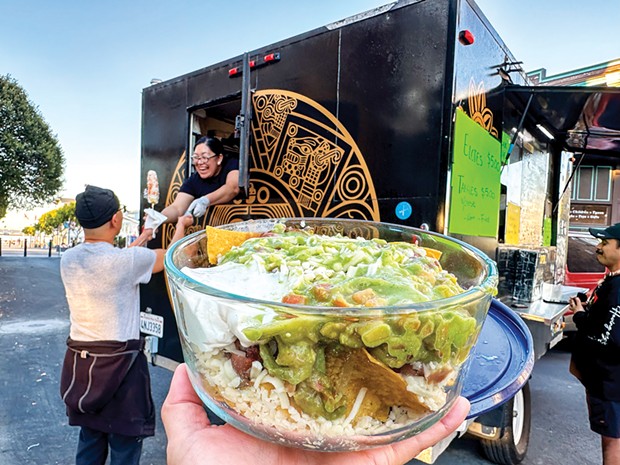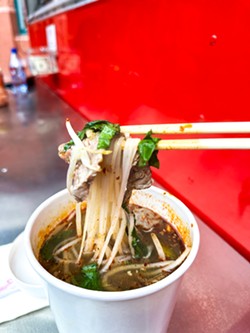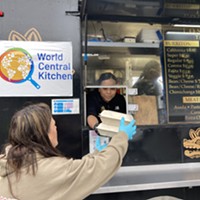
Photo by Jennifer Fumiko Cahill
Carnitas nachos from the Los Giles Taqueria truck in a glass container from home.
[
{
"name": "Top Stories Video Pair",
"insertPoint": "7",
"component": "17087298",
"parentWrapperClass": "fdn-ads-inline-content-block",
"requiredCountToDisplay": "1"
}
]
Over three years of pandemic-era takeout, we've reused the plastic containers from curries and quesabirria tacos to share leftovers, distribute cookies and trap the occasional errant spider. But we needn't have accumulated quite so many of them.
In July of 2019, Assembly Bill 619 passed, updating California Retail Food Code to allow businesses to fill customers' clean, reusable containers with food (or allow patrons to refill those containers themselves, in the case of self-serve bars and buffets). So long as customers' glass, plastic, wood or aluminum containers meet proper standards and vendors follow sanitation and hygiene protocols, we can skip the single-use plastic and other lingering packaging that, despite sometimes being billed as eco-friendly, contain potentially harmful chemicals and/or still don't break down in landfills.
Jacques Moua says he's had several customers bring their own containers to his Nou Nou's food truck, and others have cleaned and brought back his 38-ounce containers to be reused. He's happy to fill them with his fried rice, ramen and phô. "It's actually kind of nice because the containers I use are kind of pricey." Heat-proof bowls like the plastic ones Nou Nou's usually uses can run $35 for a stack of 75. When he first opened the truck, he'd hoped to use more eco-friendly options, and he admits he goes through more plastic than he'd like.
Once a week, however, Moua uses paper containers with plastic lining. "That's the only way we can serve soup at the Friday Night Market," he says, because of the event's plastic waste-minimizing requirements. But even those lidded cups, he says, don't match up to Arcata's 2020 ordinance requiring disposable foodware to be "fiber-based compostable and free of fluorinated chemicals (PFAS)." PFAS, frequently used for making containers waterproof, don't break down in landfills, and can contaminate water and bioaccumulate in wildlife.
For Moua, meeting Arcata's standard is not feasible, given the cost of fully compostable cups and bowls, and the fact that it's hard to find containers that can safely make the trip home with a serving of noodles and soup as hot as Nou Nou's turns them out. "It's nice when people bring their own containers; there's no complaints on this side at all."
Esmeralda Hernández, an owner of the Los Giles Taqueria truck, echoes Moua's willingness to serve customers with containers from home, saying she "absolutely would," though she hadn't ever been asked. She's not alone; Roman's Kitchen cook Ishmael Mendes also says he's ready to put the truck's popular burgers in customers' containers, but nobody has made the request.
Operating mainly in Arcata, Hernández's crew regularly uses compostable containers, even in other parts of the county. "They're kind of pricey but, you know, it's for the better of the Earth." While burritos get a swaddling in foil, the packaging Los Giles sends out its carne asada fries, nachos and tacos in costs $30 to $43 per 100 boxes, she says, depending on where they can source them. Sturdier serving boxes for fried chimichangas run $55 for 120 containers. And the margins in food businesses are often small enough for every penny to count.
While neither Moua nor Hernández had heard of AB 619 and the official protocols, they both say they and their staffs are already following procedures to avoid cross-contamination that match the California Food Code updates. The updates require that the container be isolated from other food and serving surfaces, possibly with a barrier like a sheet of deli paper, or that the surface be sanitized immediately after removal. Serving utensils are not to touch the customer's container; if the implements make contact, employees must swap them out for new sanitized ones.
Moua says he and his team only take a container from the customer once the order is ready for packing. "When a customer hands us their containers, they stay in our hands and I always have my employees switch their gloves [after handling it]." After nearly 20 years in food service, he says, "It's kind of like second nature to be sanitary anyways, that's how I run my food truck."
Hernández doesn't see much of a challenge taking customer containers. "I've seen other people who've done it," she says, adding she's heard of vendors offering small discounts, too. In fact, Arcata's Ordinance No. 1527 tacks on a $0.25 charge onto each order served in single-use containers. It also states, "Food Vendors must offer a minimum $0.25 discount [per order] for customers who bring their own reusable foodware for takeout food and beverage."
As the cost of ingredients and gas climb, Hernández welcomes the potential savings of using customer containers. "We don't want to bring up the prices even though things are going up," she says. "Most of our customers used to be students at Cal Poly Humboldt and they're struggling."
Not every box or bag from home is suitable for takeout. According to California Retail Food Code, businesses may only serve food in clean, durable foodware that is: "A. Safe; B. Durable, corrosion resistant and nonabsorbent; C. Sufficient in weight and thickness to withstand repeated warewashing; D. Finished to have a smooth, easily cleanable surface; and E. Resistant to pitting, chipping, crazing, scratching, scoring, distortion and decomposition." So, that cracked orange container that still smells like marinara is not going to work and neither is the cardboard box you got takeout in last time.
And while the new rules say businesses "may" fill proper home containers, they do not say they "must." Call ahead and make sure the restaurant, truck or other food business you're hitting up is willing and prepared to load your casserole dish with hot wings.
But if you can use your own container, those wings may make it home a little hotter and disappear without leaving all that plastic behind.
Jennifer Fumiko Cahill (she/her) is the arts and features editor at the Journal. Reach her at (707) 442-1400, extension 320, or [email protected]. Follow her on Instagram @JFumikoCahill and on Mastodon @jenniferfumikocahill.
Speaking of...
more from the author
-
CPH Protests and Doing Good on Cinco de Mayo
- May 5, 2024
-
Failed Leadership
- May 2, 2024
-
Mexican Restaurants Support English Express for Cinco de Mayo<
- May 2, 2024
- More »


































